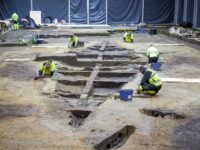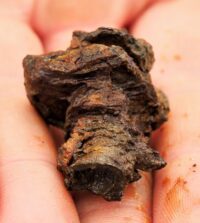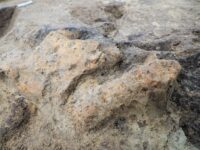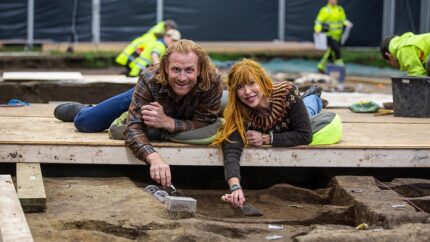 The excavation of the Gjellestad Ship, the first Viking ship burial mound to be excavated in Norway since 1904, has exposed the surviving structure of the ship. We’ve only seen its outline in a ground penetrating radar scan before, a pointed oval in the middle of a dark circle that marks the circumference of the mound that was built around it. Now the wooden skeleton of the ship itself is visible.
The excavation of the Gjellestad Ship, the first Viking ship burial mound to be excavated in Norway since 1904, has exposed the surviving structure of the ship. We’ve only seen its outline in a ground penetrating radar scan before, a pointed oval in the middle of a dark circle that marks the circumference of the mound that was built around it. Now the wooden skeleton of the ship itself is visible.
The ship was constructed around the 9th century and dug into a pit. Someone very important was laid to rest inside of it and then a mound was built on top to attest to the high rank of the deceased. The longship was an estimated 65 feet long when new. About 63 feet of its length (and 13 feet of its width) remains, with the losses concentrated and the front and back of the boat.
The excavation began at the end of June and time is of the essence because samples taken from the keel found the wood was ravaged by fungal growth and in imminent danger of disintegration. To preserve the fragile wood after it has been exposed to the air, the team drapes it in perforated plastic sheeting covered with wet cotton canvas. That keeps the soil and wood from drying out. Artifacts have been removed in soil blocks for excavation in laboratory conditions.
 The most common artifact unearthed so far are nails, the iron nails with heads and square plates hammered to the end known as clinker plates. These plates were the fasteners, the means by which the planks of clinker-built ships were kept together. As most of the ship’s wood decayed in the soil, the iron nails remained, albeit damaged and fragmented by a millennium of corrosion. Last month, a whole row of nails was uncovered on the southern end of the ship, the area where the planks from stem to stern were nailed to the prow. A corresponding line of clinker nails was also found in situ on the northern section of the ship. Their discovery in their original positions will provide new information on how the ship was built.
The most common artifact unearthed so far are nails, the iron nails with heads and square plates hammered to the end known as clinker plates. These plates were the fasteners, the means by which the planks of clinker-built ships were kept together. As most of the ship’s wood decayed in the soil, the iron nails remained, albeit damaged and fragmented by a millennium of corrosion. Last month, a whole row of nails was uncovered on the southern end of the ship, the area where the planks from stem to stern were nailed to the prow. A corresponding line of clinker nails was also found in situ on the northern section of the ship. Their discovery in their original positions will provide new information on how the ship was built.
While human remains have yet to be found, animal bones have been discovered the middle of the ship. Their large size suggests they belonged to an ox or horse that was ritually buried with the elite individual. The animal bones are located in the area of the boat where the central burial chamber  would have been placed. The site has been interfered with, probably by looters when the tomb was still comparatively young, certainly by agricultural activity in the 19th century when the mound above the burial was destroyed to make way for planting. The upper parts of the boat were heavily damaged and archaeologists feared the funerary chamber was lost as well. The discovery of the animal bones gives hope that there might be something to find down there after all, because while the top layer of bones are in poor condition, the lower layers are much better preserved.
would have been placed. The site has been interfered with, probably by looters when the tomb was still comparatively young, certainly by agricultural activity in the 19th century when the mound above the burial was destroyed to make way for planting. The upper parts of the boat were heavily damaged and archaeologists feared the funerary chamber was lost as well. The discovery of the animal bones gives hope that there might be something to find down there after all, because while the top layer of bones are in poor condition, the lower layers are much better preserved.
Follow the adventures of the Gjellestad excavation in this blog on the Viking Ship Museum’s website. Also, here is Kristofer Hivju, aka Tormund Giantsbane from Game of Thrones, looking like joy incarnate as he aids in the excavation.
